The document discusses the experimental use of recycled tyre rubber as a replacement for fine and coarse aggregates in concrete, termed 'rubcrete-mix'. This approach aims to address environmental issues by recycling tyre waste and enhances concrete's mechanical properties for various engineering applications. The study evaluates optimal replacement ratios, cement modifications with silica fume, and the resultant mechanical performance, highlighting reductions in compressive and tensile strengths with increased rubber content.
![IJRET: International Journal of Research in Engineering and Technology eISSN: 2319-1163 | pISSN: 2321-7308
_______________________________________________________________________________________
Volume: 03 Issue: 11 | Nov-2014, Available @ http://www.ijret.org 500
USING TYRES WASTES AS AGGREGATES IN CONCRETE TO FORM
RUBCRETE – MIX FOR ENGINEERING APPLICATIONS
G. Nagesh Kumar1
, V. Sandeep2
, Ch. Sudharani3
1
Sr. Assistant Professor, Department of Civil Engineering, G. Pulla Reddy Engineering College (Autonomous),
Kurnool, Andhra Pradesh, India
2
PG Student, Department of Civil Engineering, G. Pulla Reddy Engineering College (Autonomous), Kurnool, Andhra
Pradesh, India.
3
Associate Professor, Department of Civil Engineering, Sri Venkateswara University College of Engineering
(Autonomous), Tirupati, Andhra Pradesh, India.
Abstract
This paper presents the results, obtained after replacement of fine and coarse aggregates, in concrete mix, with tyre rubber. The
tyre rubber, which has been used in the present study, is obtained after the mechanical trituration process of post – consumed
tyres from trucks. Researchers have investigated, over the years, the use of recycled tyre rubber waste as a replacement for
aggregate in concrete and its effectiveness. “Rubcrete-Mix” which would result from such replacement is found to have many
engineering applications and holds promise in future. Rubcrete also possesses good mechanical properties and is considered to
be one of the best and economical ways of recycling the used tyres. The present experimental study has the aim of arriving at the
optimum quantity of the replacement material for the aggregates in concrete mixtures, for various engineering applications. For
achieving a proper bond with the surrounding concrete paste, the recycled aggregates have been designed with respect to their
size, shape and gradation. With the water – cement ratio being kept constant fine and coarse aggregate has been replaced with
tyre rubber powder and chipped rubber and also cement has been replaced with silica fume. In preparing the concrete, Portland
slag cement has been used along with super plasticizer less than 1% by weight of cement to achieve required workability of the
resulting concrete. Furthermore, durability studies have been conducted and mixes have been designed for M30 grade concrete.
Keywords: Concrete Mix, Mechanical Properties, Rubber Powder, Chipped Rubber, Silica fume.
-------------------------------------------------------------------***-------------------------------------------------------------------
1. INTRODUCTION
India has taken step to move forward in infrastructures
towards the growth of globalization. Dumping of wastes
causes serious health effects and creates environmental
problems. Now days vehicles are a major tool to everyone
for a means of transportation along with this production of
tyres are developing tremendously. After using these worn
out tyres which may be throw on open grounds, then these
places may turns to landfills. These tyre wastes slowly
raised enormously due to these depletion of land filling
occurs. Furthermore, these sites may become places to grow
rats, and provide place for mosquitoes’ breeding.
Accumulation of these stock piles of tyres will not degrade
easily but it takes more than 100 years of time because due
to presence of cross – links between the rubber polymer
chains. Since tyres are made from Petroleum by – Products
like methane hence which causes fire accidents while
burning an acrid black plume evolves and which releases a
toxic gases in air when dissolves in water it may pollute the
water and causes dreadful diseases to human beings and
organisms. It is necessary to have a clear awareness on
utilizing industrial wastes for recycling in concrete,
Otherwise, these wastes may shows a huge impact on
environment. It is an excellent way for the conservation of
traditional aggregates in environment. Recently, our Prime
Minister of India Sri Narendhra Modi Garu gave an
elaborate speech at Delhi in Swacha Bharat Programm about
eradication of pollution in environment on the October 2,
2014 it is the desire of our father of nation called Mahatma
Gandhi. Our Governor Sri Narasimhan Garu also invited us
to strive hard deligently to keep our surroundings clean and
green. In past many researchers conducted research and
presented the results on this rubberized concrete. The size,
shape and gradation play a major role in bonding with the
surrounding concrete paste in achieving strength. Most of
the experiments performed by collecting a tyre wastes from
trucks after removing the textile component and steel fibers.
In some occasions the rubber wastes are chemically
pretreated to improve the properties of concrete. Gradually,
many researchers shown interest to do research beyond of
this using waste rubber in concrete. Barluenga and
Hernandez – Olivares (2004) [1]
has been observed that
reduction of spalling damage and improve in fire resistance
by using tyre rubber in high – strength concrete slabs.
Batayneh et al., (2008) [2]
suggested that the usage of rubber
in concrete is not recommended where high strength is
required. It should be useful only where the high strength is
not required.Ganjian et al., (2009) [3]
were replaced coarse
aggregate with tyre rubber in concrete. They found that by
using tyre rubber in concrete it yields to give very less
compressive strength than when natural coarse aggregate
used in concrete.Guneyisi, E., Gesoglu, M. and Ozturan
(2004) [4]
were presented that the chloride ion penetration the](https://image.slidesharecdn.com/usingtyreswastesasaggregatesinconcretetoformrubcretemixforengineeringapplications-160827111632/75/Using-tyres-wastes-as-aggregates-in-concrete-to-form-rubcrete-mix-for-engineering-applications-1-2048.jpg)
![IJRET: International Journal of Research in Engineering and Technology eISSN: 2319-1163 | pISSN: 2321-7308
_______________________________________________________________________________________
Volume: 03 Issue: 11 | Nov-2014, Available @ http://www.ijret.org 501
degree of penetration is decreased in rubberized concrete, it
mainly depends up on the rubber content in presence of both
silica fume and without silica fume, it will accounted for a
particular w/c ratio and curing period. Hernandez – Olivares
et al., (2000)[5]
In his investigations observed that the elastic
modulus varies either under static or dynamic load increases
with age through experimentally.Najim and Hall (2005)[6]
observed that rubber incorporated mixes produces very low
unit weight mixes and with high air contents. By
incorporating rubber in concrete it improves not only
dynamic loading behavior but also impact, vibration and
absorption characteristics. Olivares et al., (2006) [7]
investigated of about fatigue behavior of tyre rubber
incorporated in concrete and also its applications on
pavements. Siddique and Naik (2004)[8]
they reported that
and gave a brief studies on using tyre rubber in concrete
they found that by the addition of tyre rubber in concrete
even though it reduces the strength of the concrete but the
main benefit is that it reduces the mass density to as low as
1750 Kg/m3
. Topcu and Bilir (2009)[9]
has been reported
that by adding tyre rubber in concrete it yields to give very
low young’s Moduli its value was 10,000 mpa because tyre
rubber softens the elastic stress – strain response. However,
Turatsinze et al., (2006)[10]
has been observed that in his
investigation by increasing the quantity of rubber shreds in
concrete it will reduces the crack length and width due to
shrinkage and it makes more delay of onset time of
cracking. Yesilata, et al., (2009) [11]
studied about the
thermal properties as a part in his research by adding
shredded wastes polyethylene bottles and automobile tyres.
The thermal transmittance of the concrete samples will be
effectively determined by using dynamic adiabatic – box
technique through carrying out thermal tests. Yesilata, et al.,
(2010) [12]
has investigated about the thermal behavior of a
building structure by using rubberized concrete exterior
walls.
In this investigation the fine aggregate and coarse aggregate
was replaced with the Rubber powder and Chipped Rubber,
finally the Portland slag cement was replaced by silica fume
in certain percentages to observe those influences on
mechanical properties in concrete. The effects of water
absorption, temperature, density and thermal insulating
properties including durability properties were also studied.
2. EXPERIMENTAL DETAILS
2.1 Materials
2.1.1 Portland Slag Cement
Portland Slag Cement (PSC), which conforms to 33 grade of
IS 455: 1989, was used. The specific gravity of Portland
slag cement was 3.1.
2.1.2 Rubber Powder
The Rubber powder will be forms by passing tyre rubber
through rotating corrugated steel drums. The obtained
material will have very large surface area. It will be useful
to replace fine aggregate. The specific gravity of Rubber
Powder is 0.55.
2.1.3 Chipped Rubber
It is used to replace the coarse aggregate and having the
dimension of about 20 mm. The specific gravity of Chipped
Rubber is 1.106.
2.1.4 Aggregates
Coarse aggregate from stone crusher having a nominal
maximum size of 20 mm was used. The specific gravity of
coarse aggregate was 2.74. River Sand was used as a fine
aggregate in mix of having a nominal maximum size of 4.75
mm was used. The specific gravity of fine aggregate was
2.65.
2.1.5 Silica Fume
The silica fume – Astra chemicals Lit-Chennai which
conform to ASTM C 1240 and IS 15388: 2003 was
used in this investigation. The specific gravity of silica fume
is 2.20.
2.1.6 Super Plasticizer
Conplast SP430 it will be appear in brown liquid and
significantly reduces water demand in a concrete mix to
improve the workability. The specific gravity of Conplast
SP430 was 1.18.
2.2 Mix Proportion
The mix proportions of different types of percentages of
replacement mixes and obtained quantities for mixes were
tabulated as below. Table 1 shows the mix proportions for
the percentage replacement of fine aggregate with Rubber
powder. Table 2 represents the mix proportions for the
percentage replacement of coarse aggregate with chipped
rubber. Table 3 gives the mix proportions for the percentage
replacement of cement with Silica fume. Finally Table 4
includes the mix proportions for the percentage replacement
of cement with Silica fume and also the fine aggregate with
Rubber Powder. Mix design procedure followed according
to IS 10262: 2009. All mix proportions are designed with a
slump ranging from 75-100mm, keeping the water content
constant at 157 kg/m3
, with the addition of super plasticizer
the required workability has been achieved. The water –
cement ratio of 0.40 is kept constant for all mixes. Fine
aggregate was replaced by Rubber Powder varying from
10% to 40% and coarse aggregate was replaced by Chipped
Rubber constantly 2.5% by weight. Cement was replaced by
Silica fume varying from 5% to 15% by weight of cement.](https://image.slidesharecdn.com/usingtyreswastesasaggregatesinconcretetoformrubcretemixforengineeringapplications-160827111632/75/Using-tyres-wastes-as-aggregates-in-concrete-to-form-rubcrete-mix-for-engineering-applications-2-2048.jpg)
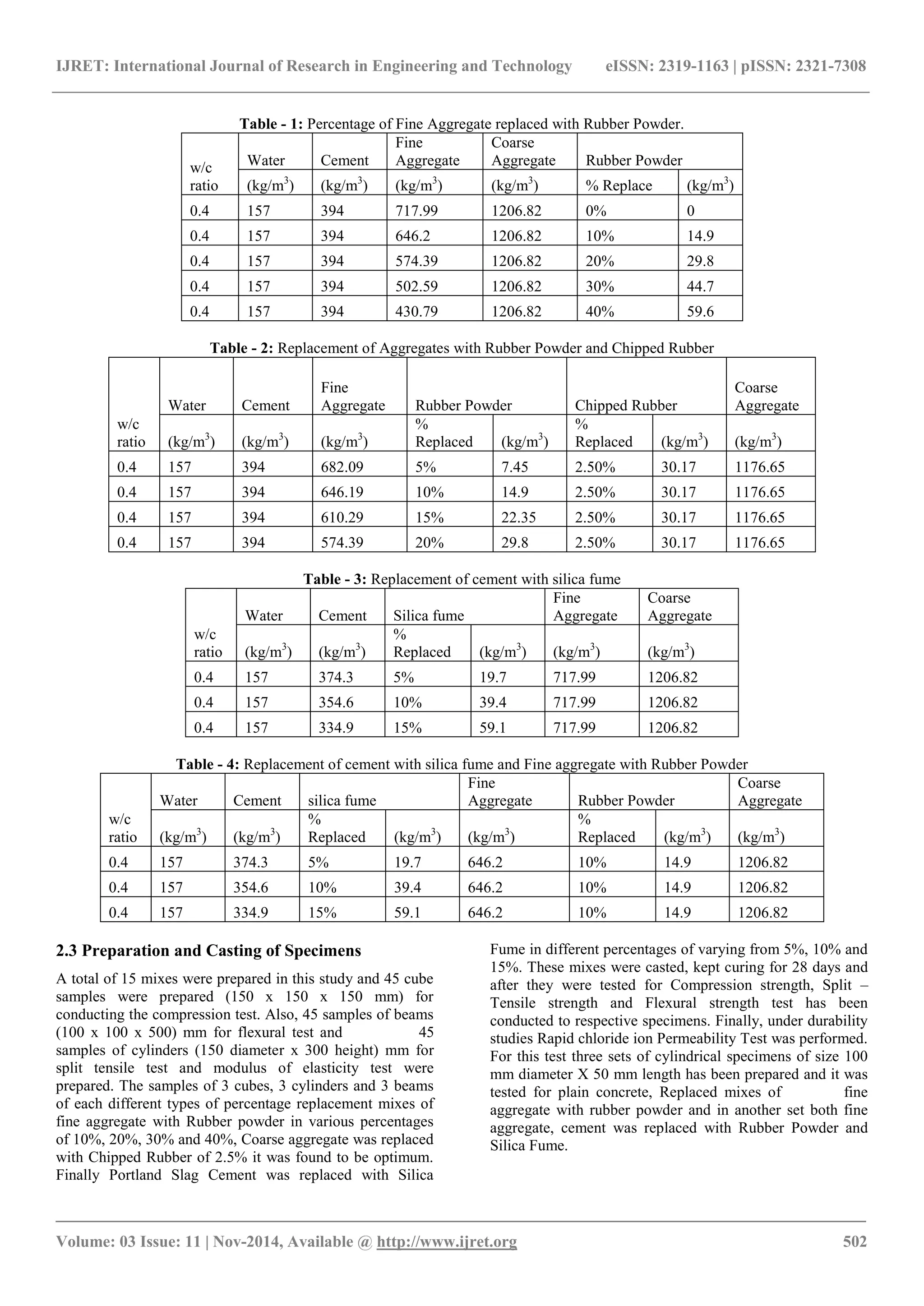
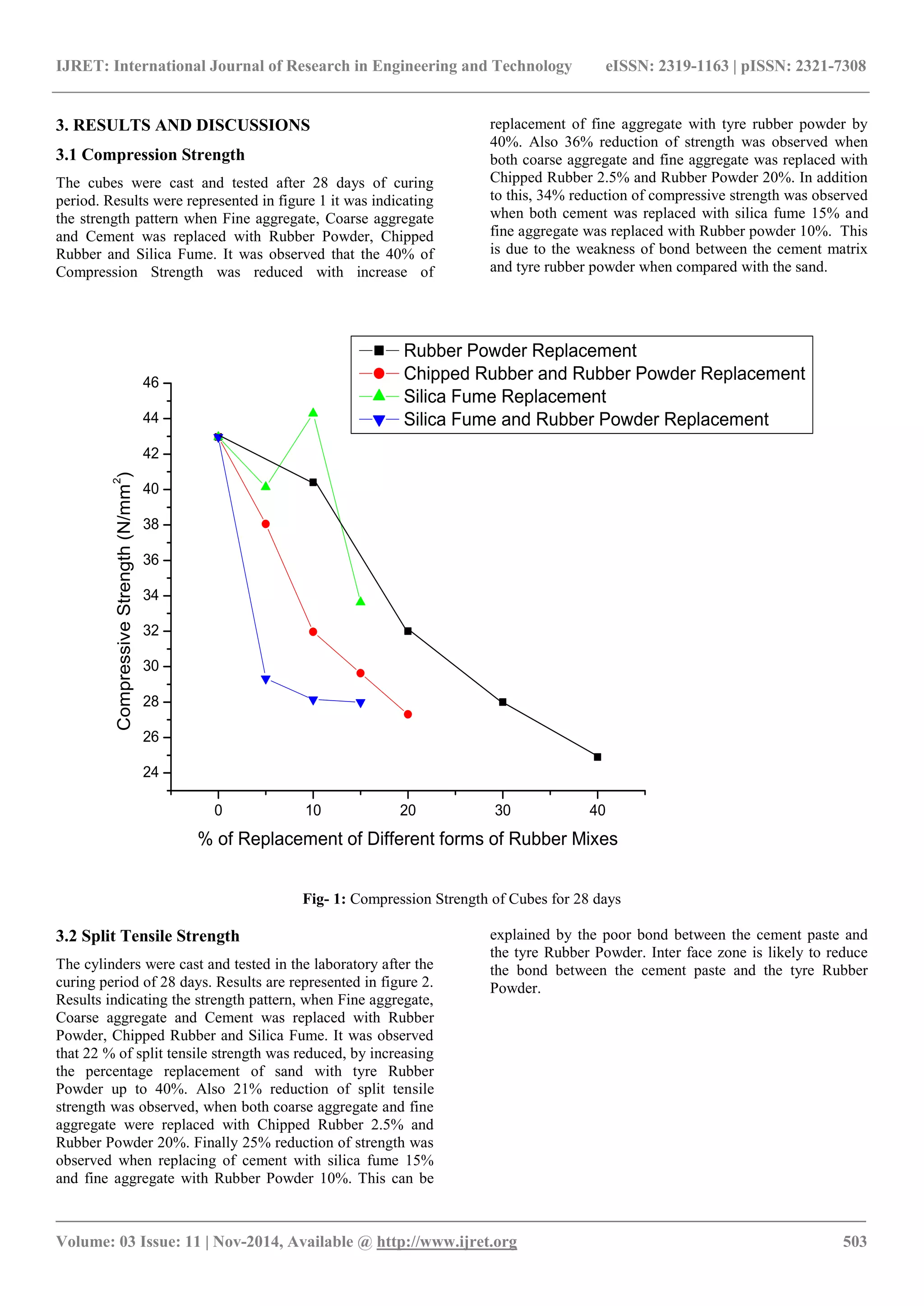
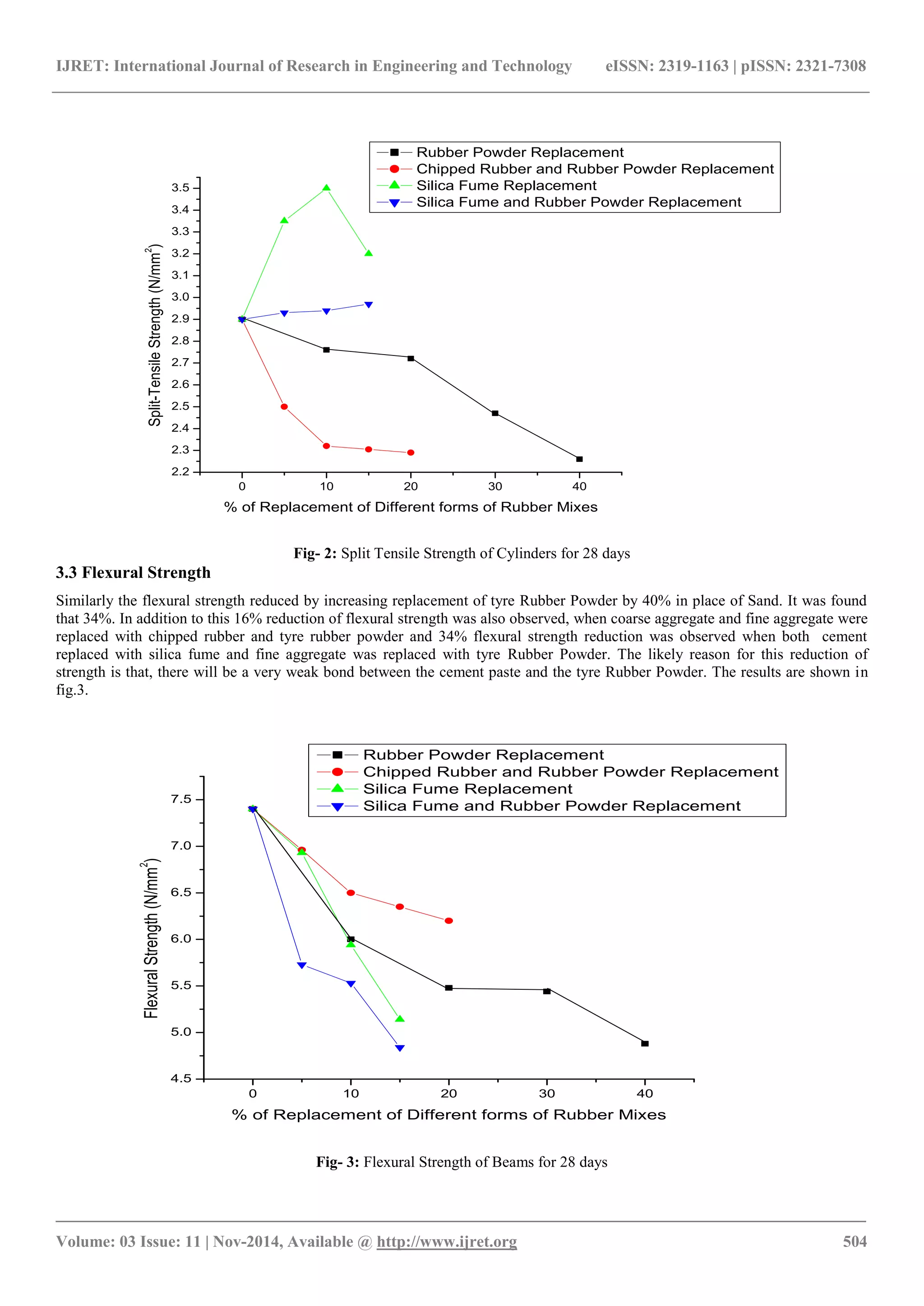
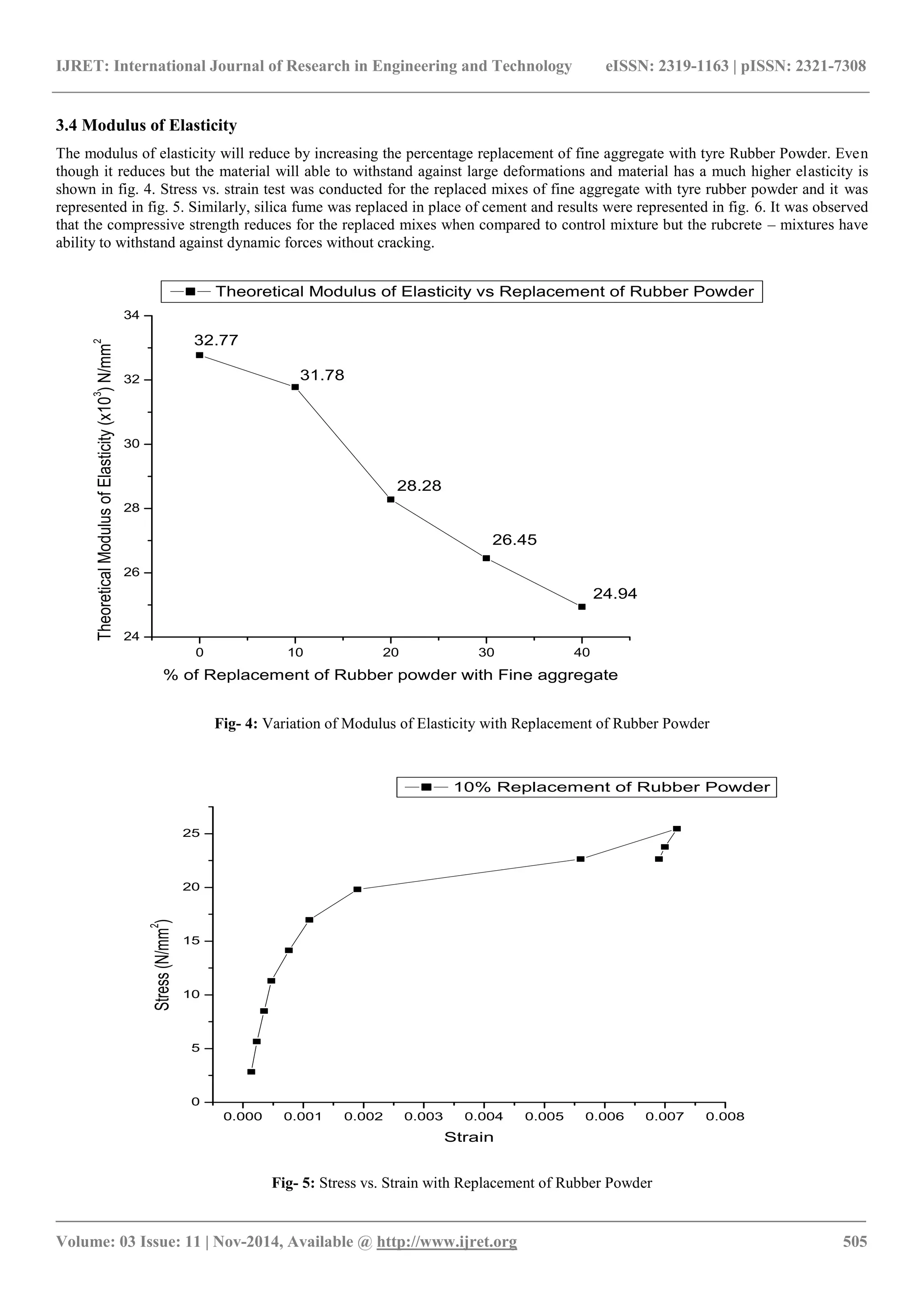
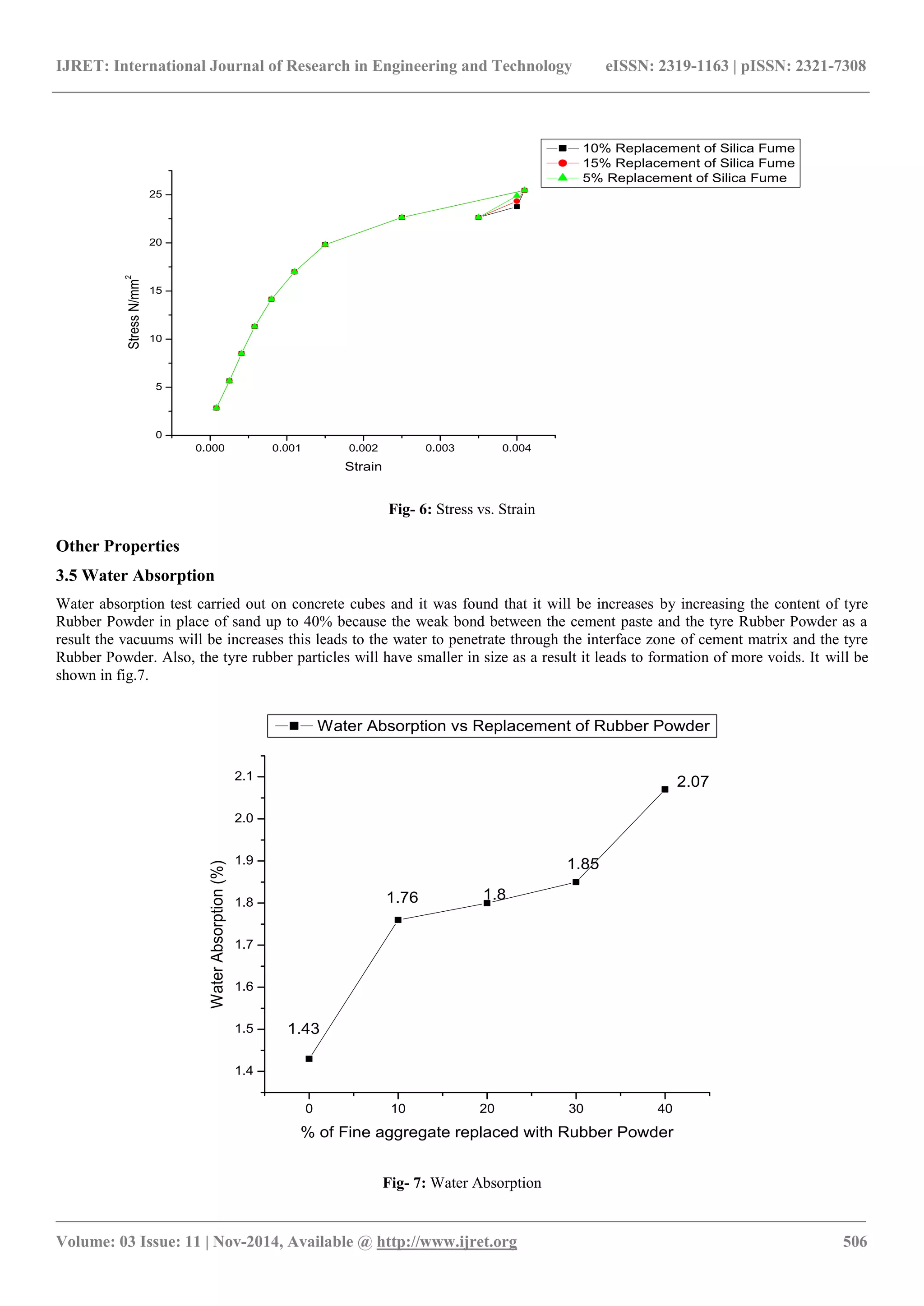
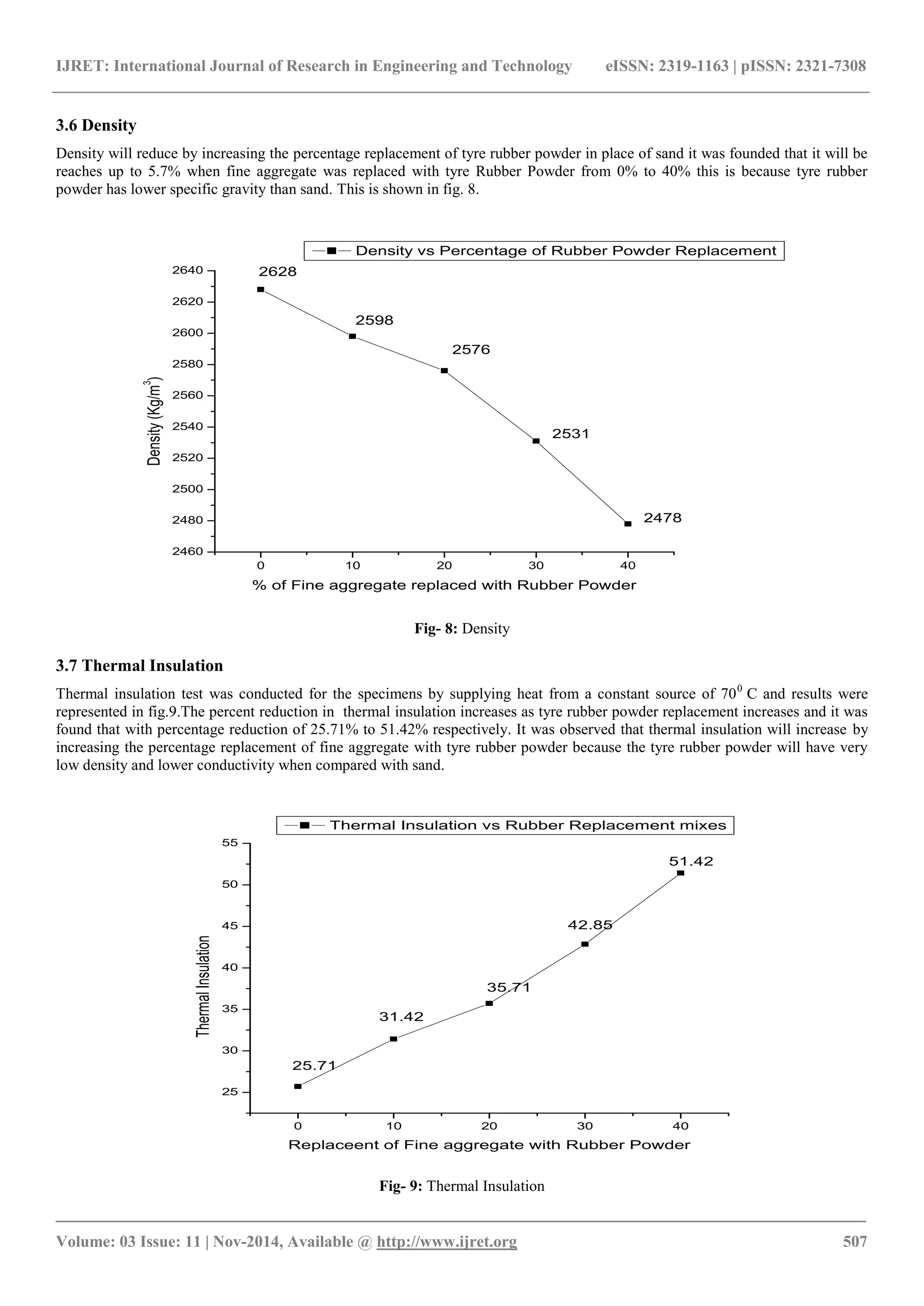
![IJRET: International Journal of Research in Engineering and Technology eISSN: 2319-1163 | pISSN: 2321-7308
_______________________________________________________________________________________
Volume: 03 Issue: 11 | Nov-2014, Available @ http://www.ijret.org 508
3.8 Rapid Chloride Ion Permeability Test
Rapid chloride ion permeability test was conducted under durability of concrete and the results are presented in Fig. 10. It was
observed that the flow of charge is low in specimens, which are having tyre rubber powder replaced with fine aggregate. From the
results, it can be concluded that the rubcrete – mix exhibits low permeability.
Fig- 10: Rapid Chloride Permeability Test
4. CONCLUSIONS
Based on the results and then analysis, the following
conclusions have been arrived it. Compressive strength of
rubber powder mixtures decreases as the percentage of
replacement of sand by rubber powder increases, for various
percentages of mixes. Density decreases as the percent of
rubber powder replacement increases, for various
percentages of mixes. Water absorption increases as
percentage of rubber powder content increases. Slump of the
concrete ranges from 75 to 100 mm. Modulus of Elasticity
decreases as rubber powder replacement increases and
higher flexibility was obtained. Thermal insulation increases
as rubber powder percentage increases. Optimum
replacement of coarse aggregate with chipped rubber was
adopted as 2.5%. Rubcrete – Mix is also one form of light
weight concrete. Use of alternative for traditional aggregates
that have been in use over the years would help in the
conservation of environment. Compressive strength
improves slightly in the presence of silica fume. Use of tyre
rubber powder leads to low permeability value, which can
be attributed to its lower density and conductivity. Low
permeability can be achieved, by use of silica fume in
concrete.
REFERENCES
[1]. Barluenga, G., Hernandez – Olivares, F., 2004. Fire
performance of recycled rubber – filled high – strength
concrete. Cement and Concrete Research 34 (2004) pp. 109
– 117.
[2]. Batayneh M.K, Iqbal M., Ibrahim A., 2008. Promoting
the use of crumb rubber concrete in developing countries.
Waste Management 28, 2171 – 2176.
[3]. Ganjian E., Khorami, M., and Maghsoudi, A.A., 2009.
Scrap – tyre – rubber replacement for aggregate and filler in
concrete. Construction and Building Materials 23 (2009)
1828 – 1836.
[4]. Guneyisi, E., Gesoglu, M. and Ozturan, T. 2004.
Properties of Rubberized Concretes containing silica fume;
cement and concrete research 34: 2309 – 2317.
[5]. Hernandez – Olivares, F., Barluenga, G., Bollati, M.,
Witoszek, B., 2002. Static and dynamic behavior of recycled
tyre rubber – filled concrete. Cement and Concrete Research
32 (10), pp. 1587 – 1596.
[6]. Najim KB. Modulus of elasticity and impact resistance
of chopped worn – out tyres concrete. Iraqi J civil Eng 2005;
1 (6): 83 – 96.
0 10 10 & 10
1500
1550
1600
1650
1700
1750
1800
1850
1900
1950
1542
1793
1915
Chlorideionpermeability(coulombs)
Percentage Replacement
Permeability vs Percentage Replacement](https://image.slidesharecdn.com/usingtyreswastesasaggregatesinconcretetoformrubcretemixforengineeringapplications-160827111632/75/Using-tyres-wastes-as-aggregates-in-concrete-to-form-rubcrete-mix-for-engineering-applications-9-2048.jpg)
![IJRET: International Journal of Research in Engineering and Technology eISSN: 2319-1163 | pISSN: 2321-7308
_______________________________________________________________________________________
Volume: 03 Issue: 11 | Nov-2014, Available @ http://www.ijret.org 509
[7]. Olivares – Hernandez F, Barluenga G. High strength
concrete modified with solid particles recycled from
elastomeric materials. In: Konig G, Dehn F, Faust T, editors.
Proceedings of the 6th
international symposium on high
strength/high performance, Leipzig, Germany, 2002. P.
1067 – 77
[8]. Siddique R., Naik T. R., 2004. Properties of concrete
containing scrap – tyre rubber – an overview, Waste
Management 24, PP. 563 – 569.
[9]. Topcu, I. B. and Bilir, T. 2009. Experimental
Investigation of some Fresh and Hardened Properties of
Rubberized Self – Compacting Concrete. Materials and
Design 30:3056 – 3065.
[10]. Turatsinze A, Bonnet B, Granju JL. Mechanical
Characterisation of cement – based mortar incorporating
rubber aggregates from recycled worn tyres. Build Environ
2005; 40(2):221 – 6.
[11]. Yesilata, B., IslKer, Y., Turgut, P. (2009). “Thermal
insulation enhancement in concretes by adding waste PET
and rubber pieces, “Elseveir, Construction and Building
Materials, Vol. 23 No. (5), pages 1878 – 1882.
[12]. Yesilata, B., Bulut, H. (2011). “Experimental Study On
thermal behavior of a building structure using rubberized
exterior – walls.” Elseveir, Energy and Buildings, Vol. 43,
Issues 2 -3, pages 393 – 399
List of Indian Standard Codes Referred:
a. IS 1199:1959 Determination Of Workability Of
Concrete.
b. IS516:1959 Methods for Testing For Strength Of
Concrete, Bureau Of Indian Standards.
c. IS 383:1970 Standard Specifications For Testing Of
Construction Materials, Bureau Of Indian Standards.
d. IS 5816:1999 Splitting Tensile Strength of Concrete –
Method of Test.
e. IS 10262:2009 (Reaffirmed 2004): Recommended
guidelines for concrete mix design, Bureau of Indian
Standards.
f. IS 455:1989 Portland slag cement – specification
fourth edition Bureau of Indian Standards, New Delhi.
g. IS 456:2000 Plain and Reinforced Concrete – Code of
Practice.
BIOGRAPHIES
G. Nagesh Kumar He has received his
M. Tech degree (Structural
Engineering) from JNTU, Anantapur,
Andhra Pradesh, India. He is currently
pursuing his research under the
guidance of Dr. CH. Sudharani at SVU,
Tirupati, Andhra Pradesh, India.
Presently, he is working as Sr. Asst. Prof in the CED of G.
Pulla Reddy Engineering College (Autonomous) and has 28
years of experience in teaching. His research interest
includes Material Sciences.
V. Sandeep holds a B. Tech degree (Civil
Engineering) JNTU A, Anantapur, India.
He is currently Pursuing his PG degree in
Structural Engineering under the
guidance of G. Nagesh Kumar Andhra
Pradesh, India. His present area of
research interest is in Material sciences.
Dr. CH. Sudharani is currently working
as Associate Professor in the civil
Engineering Department of SVU college
of Engineering (Autonomous), Tirupati,
India. She has an experience of more than
a decade in teaching and research. She has
guided a number of UG and PG project works. At present, 4
students are pursuing their Doctoral Degree under her
guidance. Her area of research interest is ANN modeling in
GTE.](https://image.slidesharecdn.com/usingtyreswastesasaggregatesinconcretetoformrubcretemixforengineeringapplications-160827111632/75/Using-tyres-wastes-as-aggregates-in-concrete-to-form-rubcrete-mix-for-engineering-applications-10-2048.jpg)